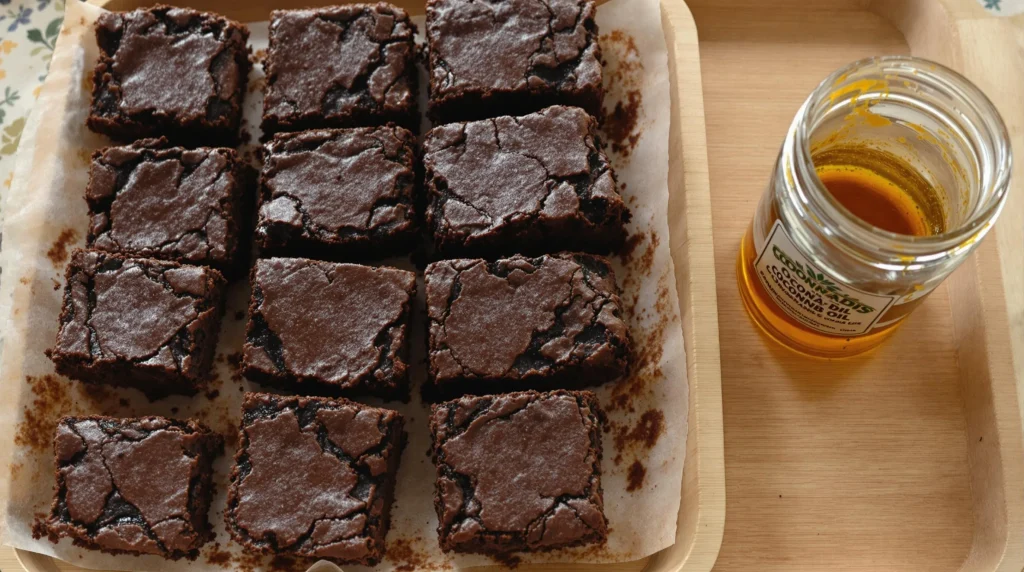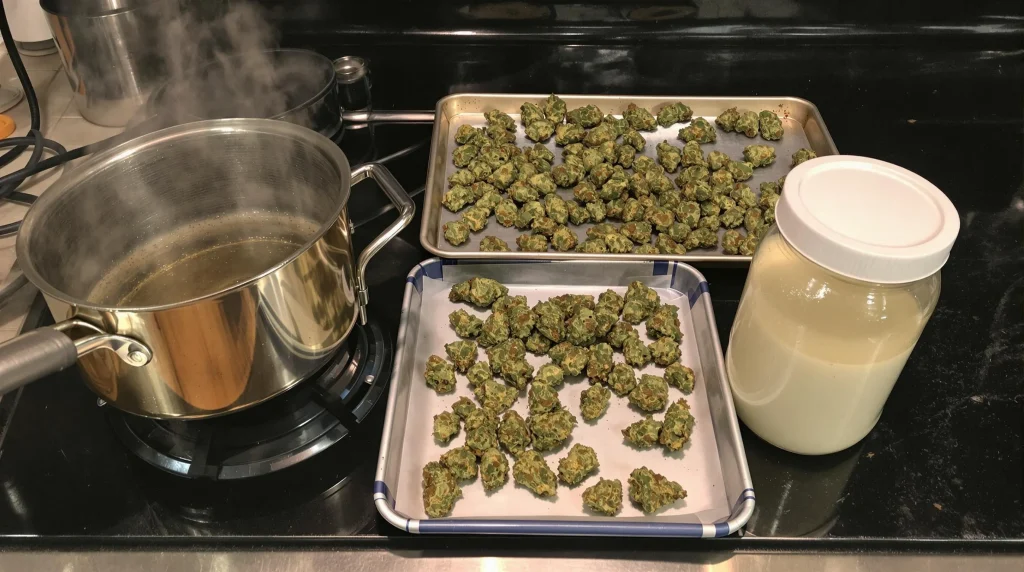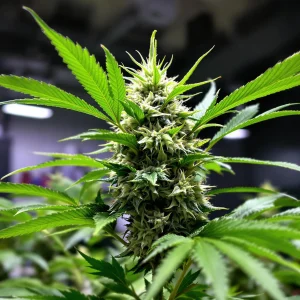When it comes to cannabis edibles, coconut oil is a game-changer. Its versatility, combined with the ability to carry THC and other cannabinoids effectively, makes it a top choice for infusions. Whether you’re baking brownies, cooking savory dishes, or creating DIY skincare, a good coconut oil weed recipe is the perfect base. If you’ve ever wondered how to make it and the best ways to use it, keep reading, we’re diving into the ultimate guide.
Why Use Coconut Oil for Cannabis?
Coconut oil has become a go-to choice for cannabis enthusiasts, thanks to its unique properties and wide range of applications. Whether you’re crafting edibles, topicals, or tinctures, coconut oil offers an exceptional base for cannabis infusions. Its compatibility with cannabinoids and versatile uses make it an indispensable ingredient in cannabis preparation.
By choosing coconut oil, you’re not only enhancing the potency and absorption of your cannabis but also expanding the possibilities for how you can enjoy it. From sweet desserts to savory meals and even skincare products, coconut oil’s versatility makes it a favorite among experienced and novice cannabis users alike.
High Fat Content
Cannabinoids like THC and CBD are fat-soluble, meaning they bind effectively to fats for better absorption in the body. Coconut oil, with its impressive 80% saturated fat content, provides an ideal medium for this process. This high fat content ensures that cannabinoids are efficiently extracted and evenly distributed throughout the oil.
The result is a potent and reliable infusion that delivers consistent effects. Compared to other oils, coconut oil’s molecular structure allows for superior cannabinoid bonding, maximizing the strength of your cannabis infusions. Whether you’re making edibles or topical treatments, coconut oil ensures you’re getting the most out of your cannabis.
Versatility
Coconut oil’s versatility sets it apart from other infusion bases like butter or olive oil. Its neutral flavor and high smoke point make it suitable for a wide variety of uses. From cooking and baking to making beverages like cannabis-infused coffee or tea, coconut oil adapts to almost any culinary or medicinal application.
Beyond the kitchen, coconut oil shines as a base for cannabis topicals. Its natural antimicrobial and moisturizing properties make it a popular choice for creating balms, lotions, and salves. Whether you’re infusing cannabis for a soothing massage oil or a flavorful curry, coconut oil’s adaptability ensures it meets your needs every time.

How to Make Cannabis-Infused Coconut Oil
Creating cannabis-infused coconut oil at home is easier than you think. This classic coconut oil weed recipe ensures your cannabis is effectively infused for maximum potency and flavor. If you’re also interested in CBD-infused skincare, you might want to try making your own CBD cream at home. With coconut oil as a base, you can create powerful topicals that nourish the skin while delivering the therapeutic benefits of cannabinoids.
Ingredients
- 1 cup of virgin coconut oil
- 7-10 grams of decarboxylated cannabis
- Cheesecloth or fine strainer
- Double boiler or saucepan
- Airtight container for storage
Step-by-Step Instructions
- Decarboxylate Your Cannabis Decarboxylation is the process of heating cannabis to activate its THC and CBD. Spread your ground cannabis evenly on a baking sheet and bake at 240°F (115°C) for 40 minutes.
- Combine Ingredients Use a double boiler or a saucepan on low heat. Add the coconut oil and decarboxylated cannabis. Stir occasionally and let it simmer for 2-3 hours to allow the cannabinoids to bind with the oil.
- Strain the Mixture Once infused, pour the mixture through a cheesecloth into a clean container. Squeeze out the remaining oil, discarding the plant material.
- Store Properly Transfer your infused coconut oil to an airtight jar and store it in a cool, dark place. Proper storage ensures freshness and potency for months.
Best Recipes Using Cannabis Coconut Oil
Now that you’ve prepared your infused coconut oil, it’s time to explore the culinary possibilities. These cannabis coconut oil recipes will inspire you to create both classic and innovative dishes, combining flavor and functionality.
Cannabis-Infused Brownies
Brownies are a timeless favorite when it comes to cannabis edibles. To make cannabis-infused brownies, substitute the butter in your go-to recipe with cannabis coconut oil. This swap not only ensures a rich, fudgy texture but also delivers a consistent infusion of cannabinoids in every bite. For an extra layer of decadence, consider adding walnuts, chocolate chips, or a swirl of caramel.
For the best results, allow the brownies to cool completely before cutting them into servings. This step ensures the oil sets properly and each piece has an even potency. Cannabis brownies are perfect for parties, relaxing evenings, or sharing with fellow enthusiasts.
If on the other hand you prefer hot chocolate with weed, here is the recipe
Savory Stir-Fry
Cannabis coconut oil isn’t limited to sweet treats. Its high smoke point and neutral flavor make it an excellent choice for savory dishes, such as a vegetable stir-fry. Begin by heating cannabis coconut oil in a wok or skillet, then add garlic, ginger, and your choice of fresh vegetables. Toss in soy sauce, sesame oil, and a dash of chili flakes for a flavorful, infused meal.
Stir-fry is versatile and quick to prepare, making it ideal for experimenting with different vegetables and proteins. Pair it with steamed rice or noodles for a satisfying, cannabis-infused dinner that’s both nutritious and delicious.
Relaxing Golden Milk
Golden milk is a comforting beverage known for its soothing properties. To make a cannabis-infused version, heat a cup of milk (or a dairy-free alternative) and stir in a teaspoon of cannabis coconut oil. Add turmeric, cinnamon, a pinch of black pepper, and a drizzle of honey for sweetness.
This warm drink is perfect for unwinding after a long day. The cannabis coconut oil enhances its relaxing effects, making golden milk a favorite among those seeking a calming nighttime ritual.
Tips for Perfect Cannabis Infusions
Creating a flawless cannabis coconut oil infusion requires attention to detail. These tips will ensure your recipes are both potent and delicious.
Decarboxylation Is a Must
Decarboxylation is the process that activates the cannabinoids in cannabis, making them bioavailable for your body. Always decarboxylate your cannabis before infusing it into coconut oil. Skipping this step will result in a weaker infusion, as raw cannabis lacks active THC or CBD.
Keep the Heat Low
When infusing cannabis into coconut oil, use low heat to preserve the potency of cannabinoids and terpenes. High temperatures can degrade these compounds, diminishing both flavor and effectiveness. A slow simmer on the stovetop or a double boiler setup works best for maintaining the oil’s quality.
Test the Potency
Every batch of cannabis coconut oil can vary in strength depending on the strain and infusion method. Test the potency by starting with a small amount and observing its effects. This approach helps you gauge the ideal dosage for future recipes, ensuring a pleasant and controlled experience.
How to Store and Use Cannabis Coconut Oil
Proper storage is key to maintaining the freshness and potency of your cannabis coconut oil. Follow these guidelines to keep your infusion at its best.
Airtight Containers Are Key
Store your cannabis coconut oil in an airtight container to protect it from air and moisture. Exposure to these elements can degrade cannabinoids over time, reducing the oil’s effectiveness. Label the container with the strain used and the preparation date for easy reference.
Keep It Cool
Heat and light are the enemies of cannabis infusions. To extend its shelf life, store your oil in the refrigerator. If you plan to keep it for longer periods, freezing is an excellent option. Portioning the oil into ice cube trays makes it easy to thaw just the amount you need.
Beyond Cooking
Cannabis coconut oil isn’t just for the kitchen. Its moisturizing and anti-inflammatory properties make it ideal for topical applications. Use it as a massage oil for sore muscles, a base for homemade balms, or even in cannabis capsules for precise dosing. Its versatility ensures it’s a valuable addition to your wellness routine.
Popular Strains for Infusing Coconut Oil
The strain you choose greatly influences the flavor, aroma, and effects of your cannabis coconut oil. Here are some top picks for creating memorable infusions.
Girl Scout Cookies
Girl Scout Cookies is a hybrid strain known for its sweet, earthy flavor and balanced effects. It’s a favorite for those seeking a versatile infusion that works well in both desserts and savory dishes. The strain’s relaxing yet uplifting effects make it ideal for creating cannabis coconut oil that can be used throughout the day.
When infused into coconut oil, Girl Scout Cookies enhances recipes with its rich aroma and subtle sweetness. It’s particularly well-suited for baked goods like cookies and brownies, but it also adds depth to savory dishes like sauces and marinades. This strain’s adaptability makes it a staple for cannabis chefs.
Lemon Haze
Super Lemon Haze is a sativa-dominant strain celebrated for its vibrant citrus flavor and energizing effects. This strain pairs beautifully with coconut oil’s tropical notes, creating a refreshing infusion perfect for daytime use. Its zesty profile makes it an excellent choice for smoothies, salad dressings, and citrus-glazed pastries.
Beyond its flavor, Lemon Haze is known for its uplifting and creative effects, making it a great option for those looking to infuse cannabis into dishes that inspire and energize. Whether in a light dessert or a tangy sauce, Lemon Haze-infused coconut oil adds brightness and functionality to any recipe.
Northern Lights Auto
Northern Lights Auto is an indica strain renowned for its deep relaxation and earthy aroma. It’s a top choice for evening infusions, providing calming effects that are perfect for unwinding. Northern Lights coconut oil is ideal for recipes aimed at relaxation, such as hot chocolates, bedtime teas, or indulgent desserts.
The earthy tones of this strain pair well with rich, comforting dishes, enhancing recipes like creamy soups or buttery pastries. Its ability to create a soothing experience makes it a popular choice for those seeking tranquility in their cannabis-infused creations.
Benefits of Cannabis Coconut Oil
Infusing cannabis into coconut oil combines the therapeutic properties of both ingredients, making it a powerhouse for wellness and culinary creativity.
Versatile Uses
Cannabis coconut oil is incredibly versatile, serving as the base for edibles, topicals, and capsules. Use it to enhance your morning coffee, bake it into cookies, or massage it onto sore joints. Its wide range of applications makes it a staple for cannabis enthusiasts.
Easy to Digest
Coconut oil’s high MCT (medium-chain triglyceride) content makes it easy for the body to digest and absorb. This ensures a faster onset and more consistent effects compared to other fats. It’s an excellent choice for those seeking quick and reliable results from their cannabis infusions.
Customizable Dosage
Making your own cannabis coconut oil allows you to control the dosage, tailoring it to your needs. Whether you prefer a mild infusion for daytime use or a potent batch for nighttime relaxation, you have the flexibility to adjust the strength to suit your preferences.

FAQs About Coconut Oil Weed Recipe
How long does cannabis coconut oil last?
When stored correctly, cannabis coconut oil can last up to six months. The key to maintaining its freshness and potency is to keep it in an airtight container, protected from light, air, and heat. A cool, dark pantry is sufficient for short-term storage, but refrigeration is recommended for extending its shelf life.
Can I use coconut oil for non-edible cannabis products?
Absolutely. Cannabis coconut oil is highly versatile and an excellent base for non-edible products. Its natural moisturizing and antimicrobial properties make it ideal for creating balms, lotions, and salves. Infused coconut oil can soothe sore muscles, hydrate skin, and even assist in managing localized pain when applied topically.
How do I calculate the dosage of my cannabis coconut oil?
To calculate the dosage of your cannabis coconut oil, start by determining the THC content of your cannabis flower (usually listed as a percentage). Multiply the total grams of cannabis used by the THC percentage to find the total milligrams of THC in the batch. Then, divide this number by the total amount of oil used to calculate the THC per milliliter or teaspoon of oil.





